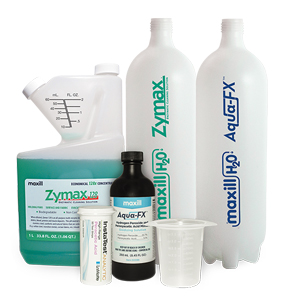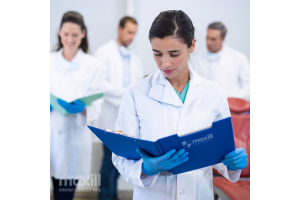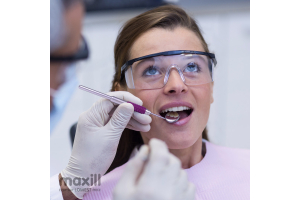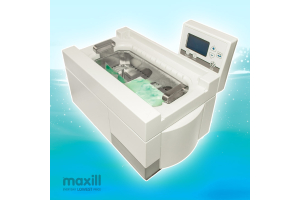DUWL Regimen and Product Selection During Extended Closure of a Dental Practice
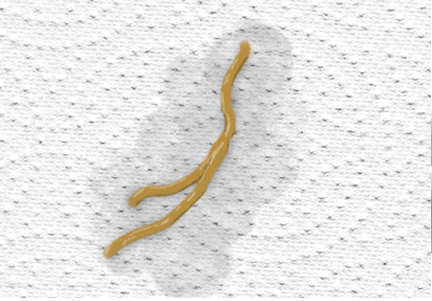
In the last article, I discussed the need to reflect on DUWL as part of the pre-planning to eventually return to practice once the coronavirus pandemic emergency state is lifted. I received many inquiries on product selection ranging from a regular maintenance program to the ‘oh no my DUWL biofilm is out of control’ action program.
My Mission: Waterlines
DUWL has become a mission of mine. My most recent publication in the CDHA (Canadian Dental Hygiene Association) professional publication “Oh Canada” (www.cdha.ca) is a three-part series on the cleaning, disinfecting, and testing of DUWL. I have spoken on the topic with ODHA (Ontario Dental Hygiene Association) at the last Re-Energize conference and again this coming September.
Why is it my mission?
Or better yet when did it become my mission? It became my mission the very first time I witnessed a blocked air-water syringe. Once disassembled, I was subject to an image that cannot be erased, the gruesome sight of what looked like a long brown worm, identified as a compact matrix of a biofilm community living happily inside the air-water syringe. This is presented in an operatory that was used the least and again as I stated in the last article, it is a large misconception to think that the water sources the least used will have less biofilm. DUWL, like all other equipment in the dental office, needs a maintenance regimen.
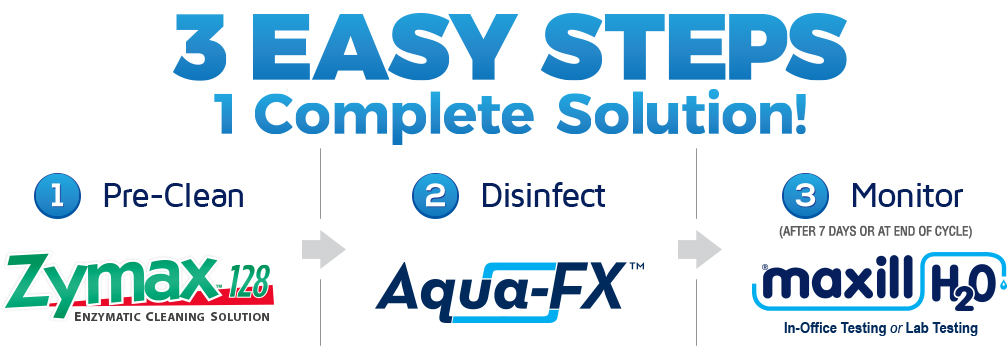
Step One: Cleaning
Think of what the action of cleaning is doing. Cleaning removes the bioburden from the surface and reduces the number of microorganisms. Note the keywords ‘remove’ and ‘reduce’. A surface that has fewer microorganisms will be easier to disinfect. The disinfecting chemical will not need to work as hard and will yield optimal results. Parallel this with cleaning and sterilization. Instruments are cleaned as it is common knowledge that if there is gross debris, even in a minute amount, that exact area will not be sterilized.
This same concept applies to cleaning and disinfecting. The narrow circumference of the DUWL is the surface that needs to be cleaned. Since there is no possible way to place a scrubbing object in the line, the next best thing must be employed, a cleaner that has some ‘oomph’ to it. Enzymatic cleaners are ideal for DUWL as they break down the biofilm into smaller particles. Going back to high school biology and chemistry the following is a very basic view for the catalytic reactions of the different types of enzymes:
- Lipases: Break down fat molecules (oils and greases)
- Proteases: Break down protein molecules (blood and food)
- Amylases: Break down starch molecules (saliva … amylase breaks down the starch in the oral cavity into glucose molecules)
The term bio-enzymatic cleaner is often seen on the label of dental office cleaners. This refers to a blend of various enzymes and bacteria to offer effectiveness against multiple types of debris. This is where manufacturers have their own ‘recipe’ where they have shopped for enzymes that are specific to a breakdown of what they are aiming to clean. maxill offers Zymax as an eco-friendly multipurpose cleaner that is very effective for DUWL, suction lines, pre-soak of instruments, pre-spray of instruments, and the ultrasonic bath. It is a blend of enzymes in a low-foaming solution that loosens and removes dried debris, blood, protein, and mucin deposits.
This pH-neutral solution will safely clean plastics, rubber, stainless steel, and synthetic and natural fabrics that are soiled with organic debris. Without releasing maxill’s enzyme ‘recipe’, Zymax is perfect for DUWL as it has the ideal combination of enzymes to clean the narrow DUWL and reduce the biofilm flora. It is not a one-time deal for cleaning, it must be a regular frequency to reintroduce more enzymes into the narrow DUWL. A good way of thinking about the cleaning process of DUWL is to associate it with the action of the enzymes. The enzymes are breaking down the biofilm, hence the need to keep attacking the biofilm with the enzymes!
Step Two: Disinfecting
Only when the DUWL is cleaned and the biofilm reduced will the disinfecting process have optimal function. There is a wide variety of disinfecting chemicals. In the past DUWL were often disinfected with sodium hypochlorite. For the seasoned dental professionals reading this article, you may remember the chaos this caused in the late 80s early 90s. The DUWL lines were indeed disinfected but the small counterparts, like 0-rings, were disintegrated! maxill has the solution for a chemical that is non-corrosive.
The product Aqua-FX is composed of peroxyacetic acid (PAA) (5.1%) and hydrogen peroxide (22.7%). Don’t let the word ‘acid’ scare you as it presents a very neutral pH. In Aqua-FX the active PAA contains a high number of hydroxyl radicals delivering a powerful oxidation effect. The hydroxyl radical has one of the strongest oxidation potentials delivering the ideal DUWL disinfection.
It reacts with the biofilms molecules providing fast and effective destruction at the sub-molecular level. PAA is NOT new in the lineup of water-related and narrow tubing disinfection. It has been used for many years in the following sectors: food and beverage manufacturing, pulp and paper mills, medical equipment, cooling towers, water treatment plants, etc. Aqua-FX has been a pillar in maxill’s chemical lineup of products for many years.
Aqua-FX requires to be mixed with water, dispensed via the DUWL water bottle delivery system (closed water system) and flushed the same day. It does not remain in the lines overnight. It does not need to remain in the lines overnight as it offers enough ‘kick’ to the biofilm layer to destroy it immediately. At a ratio of 10mL to 900 mL of H20, it is highly economical. Aqua-FX’s MIFU includes the use of a test strip post-disinfection.
For the swimming pool and hot tub owners, you are familiar with a test strip that confirms the presence of chemicals in the water. This is the opposite, a test strip to confirm the lack of chemicals in the water. This offers reassurance that only water is being delivered and dispensed in the client’s mouth. If that wasn’t amazing enough, there is another bonus to the use of Aqua-FX , it is environmentally friendly!!! Once used, it naturally breaks down into its simplest components of oxygen, carbon dioxide and water.
Step 3: Testing
Why test?
Testing is the only way to confirm that the system you are using is effective in having controlled the bio-film.
There are two types of testing in a dental office. The first is a CFU count per millilitre (colony forming count) performed by a laboratory service and requires the collection of water and plating. Heterotrophic Plate Count (HPC) (aka Standard plate count) is the method utilized to measure CFU on culture media.
The objective is to aim for a low HPC to reduce the risk of more hazardous microorganisms growing (Legionella, /E. Coli). The lower the better for the HPC and the MIFU for DUWL typically state 200-250 CFU/ml. 500 CFU/ml are the acceptable CFU in potable water, however, the dental office needs to aim for a lower count because in the world of biofilm, the jump from 200 to 500 can happen quickly and sets the stage for an action stage of repeating the clean and disinfect several times before going back to a maintenance stage.
The second testing approach is hygienic monitoring which is acceptable for use in dental offices. Hygienic monitoring provides a ‘legend’ for interpretation towards a bacterial count (CFU), typically with specifications of a pass, caution or fail.
maxill offers both testing approaches where dental offices can collect samples via test tubes that are sent to the office and returned to maxill for a heterotrophic plate count. If offices prefer to do their own testing, maxill offers a hygienic monitoring system employing the use of dip slides and an incubator supporting the user with logging forms for record-keeping compliance.
I do owe you an apology! In literature and conversation, the process of cleaning, disinfecting and testing is not presented as a clear picture. This three-part equation gives the illusion that if the steps are followed in that order, away you go.
It can be that simple, in the scenario where the biofilm is under control, but it is certainly NOT the scenario when the biofilm is out of control.
No different than treating periodontitis, clients stay in the maintenance stage when the bacteria are controlled but can regress to an active stage of care when the bacteria (or other contributing factors) are overloading the sulcus.
Testing and Purging
In dentistry we already know that non-surgical periodontal therapy (NSPT) can navigate back and forth from maintenance to active, DUWL are the same. However, if the maintenance is regimental and the frequency is observed, dental offices will not need to be in the active stage to see successful testing outcomes.
The previous article on DUWL stated dental offices needed to have a return-to-work plan for the DUWL. If the DUWL in the office were not ‘shut down’ properly in a closed water system, water will remain in the lines and cause an increase in the growth of the biofilm as it sits pooling.
A proper shutdown is to empty the water from the bottles completely, turn the water controls off and do a full air purge.
Municipal offices do not have water bottles so turn the water off and air purge all the lines. Once returning to work, the DUWL should receive attention at least 2 weeks before opening. The return will include a clean, disinfect and test in the first week. If the testing yields favorable results then the biofilm has remained controlled.
If the testing yields unfavorable results, the biofilm has had a party while you were away. The second week will allow sufficient planning in case the office fell out of maintenance and resorts back into an active stage. This will leave time to clean and disinfect repeatedly until the testing passes. In rare scenarios, the lines may require to be changed when the equation is repeated with no passes.
Manage The Risks
DUWL falls under IPAC and IPAC is governed by risk management. Simply walking in and starting work without addressing DUWL would be an elevated risk.
Understanding the entire spectrum of DUWL makes it much easier to initiate a system if one is not in place or be aware of the components of a full system if there is one currently in place and confirm the proper decisions are being made.
In conclusion, maxill can offer Zymax and Aqua-Fx as viable solutions to your DUWL maintenance. Another point to be made on both these products is their CANADIAN origin. Made right here in my hometown of St. Thomas Ontario!!!
Safe, simple, effective, and Canadian, eh?



